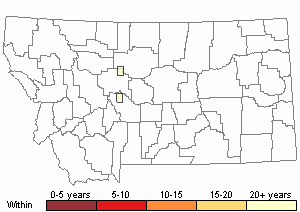View in other NatureServe Network Field Guides
NatureServe
Montana
Utah
Wyoming
Idaho
Wisconsin
British Columbia
South Carolina
Yukon
California
New York
American Funaria Moss - Funaria americana
Other Names:
A Cord Moss
General Description
Plants: Acrocarpous, growing in upright clumps or with a little more space amongst individuals, pale and olivaceous (FNA 2007) or green with yellow tones (Lawton 1971), 2-5 mm in height. Stems simple, comose (FNA 2007).
Leaves: Bent and twisted when dry (Lawton 1971), spreading to about 45 degrees (FNA 2007), cupped, lance-shaped with ovate or oblong tendencies (Lawton 1971), tapering slowly to the narrow, long-acuminate apex, small below, becoming larger above, the upper leaves 2-3 mm in length; margins smooth throughout or finely saw-toothed above (FNA 2007); acumen filiform (Crum & Anderson et al., 1981); costa wider at the base than above, disappearing near the leaf tip (FNA 2007).
Leaf Cells: Lower laminal cells rectangular, transitioning to large, diamond or 6-sided shapes with fine walls in the distal and medial part of the leaf; marginal cells more slender (FNA 2007).
Phenology
Fruit ripens in spring (Crum & Anderson et al., 1981).
Diagnostic Characteristics
The wide leaves, inner and outer peristome teeth opposite each other, and unique stomata on the capsule are characteristic of the Funariaceae (FNA 2007).
Range Comments
Endemic to North America. Georgia, Illinois, Kansas, Minnesota, Oklahoma, Endemic to North America. USA: CO, NE to TX, AR, MN, WI, IL, OH, PA, TN and GA; Mexico (FNA 2007). Known in Montana from Cascade and Meagher Counties (Elliott & Pipp, 2016).
Observations in Montana Natural Heritage Program Database
Number of Observations: 2
(Click on the following maps and charts to see full sized version)
Map Help and Descriptions
Relative Density

Recency


 (Observations spanning multiple months or years are excluded from time charts)
(Observations spanning multiple months or years are excluded from time charts)
Migration
A pioneer species occurring in open habitats such as among widely-spaced clumps of grass and disturbed sites (FNA 2007), damp soil, humus (Lawton 1971); calciphilic; occurring at medium elevations or lower (FNA 2007).
Reproductive Characteristics
Autoicous. Sporophytes usually numerous. Antheridia-bearing branch at the stem bottom. Seta almost straight, 6-10 mm tall, carrying the capsule beyond the perichaetial bracts. Capsule somewhat long and pear-shaped, 1.5-2 mm in length, constricted proximal of the opening when dry, not furrowed; neck almost the length of the sporangium with stomata each consisting of a small, narrow opening in a rounded guard cell (FNA 2007); operculum shortly cone-shaped to almost flat (Lawton 1971); exostome divisions deltoid to lance-shaped, with fine longitudinal ridges and papillae above and below, transversely-ridged on the inner surface; endostome sections opposite of the exostome teeth (Lawton 1971), with small papillae. Calyptra draping like a hood (FNA 2007).
Stewardship Responsibility
References
- Literature Cited AboveLegend:
 View Online Publication
View Online Publication Crum, H.A. and L.E. Anderson. 1981. Mosses of Eastern North America. 2 volumes. Columbia University Press, New York. 1328 pp.
Crum, H.A. and L.E. Anderson. 1981. Mosses of Eastern North America. 2 volumes. Columbia University Press, New York. 1328 pp. Elliott, J.C. and A.K. Pipp. 2018. A Checklist of Montana Mosses (1880-2018). Updated 3 January, 2020. Montana Natural Heritage Program, Helena, Montana. 73 pp.
Elliott, J.C. and A.K. Pipp. 2018. A Checklist of Montana Mosses (1880-2018). Updated 3 January, 2020. Montana Natural Heritage Program, Helena, Montana. 73 pp. Flora of North America Editorial Committee, eds. 2007. Flora of North America North of Mexico. Volume 27. Bryophytes: Mosses, Part 1. Oxford University Press, Inc., NY. xxi + 713 pp.
Flora of North America Editorial Committee, eds. 2007. Flora of North America North of Mexico. Volume 27. Bryophytes: Mosses, Part 1. Oxford University Press, Inc., NY. xxi + 713 pp. Lawton, E. 1971. Moss Flora of the Pacific Northwest. Hattori Botanical Laboratory. Japan: Yamabuki-cho, Shinjuku-ku, Tokyo. 362 pages plus appendices.
Lawton, E. 1971. Moss Flora of the Pacific Northwest. Hattori Botanical Laboratory. Japan: Yamabuki-cho, Shinjuku-ku, Tokyo. 362 pages plus appendices.
- Additional ReferencesLegend:
 View Online Publication
View Online Publication
Do you know of a citation we're missing? Elliot, J. C. 1993. Second checklist of Montana mosses. Unpublished report. U.S. Forest Service, Region 1. Missoula, MT. 45 pp.
Elliot, J. C. 1993. Second checklist of Montana mosses. Unpublished report. U.S. Forest Service, Region 1. Missoula, MT. 45 pp. Lawton, E. 1971. Keys for the Identification of the Mosses on the Pacific Northwest. Reprinted from 'Moss Flora of the Pacific Northwest'. Published as Supplement No. 2 of the Journal of the Hattori Botanical Laboratory. Nichinan, Miyazaki, Japan. 66 pp.
Lawton, E. 1971. Keys for the Identification of the Mosses on the Pacific Northwest. Reprinted from 'Moss Flora of the Pacific Northwest'. Published as Supplement No. 2 of the Journal of the Hattori Botanical Laboratory. Nichinan, Miyazaki, Japan. 66 pp.
- Web Search Engines for Articles on "American Funaria Moss"





